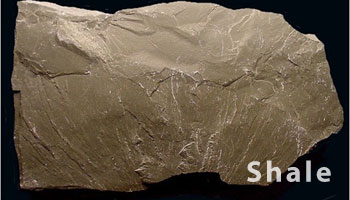Clastic sedimentary rocks form by weathering processes which break down rocks into pebble, sand, or clay particles by exposure to wind, ice, and water. Clastic and nonclastic sedimentary rocks are the only members of the rock family that contain fossils as well as indicators of the climate (ripple marks, mudcracks and raindrops) that was present when the rock was formed.
Clastic sedimentary rocks are named according to the grain size of the sediment particles.
Conglomerate = coarse (64 mm to >256 mm), rounded grains
Breccia = coarse (2mm to 64 mm), angular grains
Sandstone = grains ranging in size from 2mm to 1/16 mm
Shale = grains ranging in size from 1/16 mm to
Try This!
So, how can you tell grain size? Easy! Your fingers can feel the grains of sandstone even at the fine-grained end. Shale will feel smooth to your fingers, but it can be further separated into siltstone and claystone by rubbing a little across your teeth. Siltstone will feel gritty and claystone will feel smooth.

